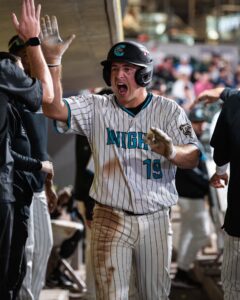2014 White Sox Minor League Statistical Leaders – Relievers
With the 2014 minor league seasons completed, let’s take a look at the leaders in key statistical areas in the White Sox system. In this edition, we’re going to focus on relief pitchers (anyone who didn’t start most of their games). We’ll look at some classic core numbers (WHIP), but also some peripheral values (H, BB and K rates) that sometimes better reflect performance.
Separate articles on hitting leaders and starting pitching leaders have gone up in the past two weeks. We’re now on relievers, our last chapter in this series.
Note: Statistical performance is not the same as prospect ranking or perceived future impact. In fact in many cases, these can be very different things. We’ll touch on that with some notes on each leader board below.
*Special Note on relievers: you’ll notice there are a lot of rookie ball pitchers with relatively low inning counts dominating these lists. We set the minimum of 20 innings pitched for these lists so that we could capture pitchers from all levels – in the rookie leagues, most relievers have 20-40 innings in a season. The small sample size does lend itself to wider variance and more extremes, but leaving out relievers in the 20-30 inning range would remove some of the more interesting bullpen arms in the system. So we left them in.
These numbers are from 2014, minor leagues, state-side affiliates only. Lefties marked with an asterisk. For pitchers there is a minimum of 20 innings pitched to be considered…
WHIP (Walks + Hits per Inning Pitched)
| Player | Level | IP | WHIP |
| Tanner Banks* | Rk, A | 24.1 | 0.90 |
| Devon Davis* | Rk | 29.2 | 1.01 |
| Josh Goossen-Brown | Rk | 21.1 | 1.08 |
| Aaron Bummer* | Rk | 22 | 1.09 |
| Ben Brewster* | Rk, A, A+ | 24.2 | 1.10 |
| Alex Powers | Rk, A | 45.2 | 1.12 |
| Mike Gomez* | Rk | 21.1 | 1.13 |
| Brannon Easterling | Rk | 33.1 | 1.14 |
| Brad Salgado | Rk, A | 39 | 1.15 |
| Jarrett Casey* | A+, AA, AAA | 67.1 | 1.20 |
You may be wondering why we aren’t covering ERA here as we did with starters. That’s because ERA is simply not a good evaluation of relievers. WHIP is probably the best “core” stat to reflect overall reliever performance, so that’s where we start.
Not only did most of these pitchers with the best WHIPs in the system get all or a big part of their innings in rookie ball, but six of the 10 were 2014 draft picks. Six were lefties as well.
Tanner Banks shows up on every top 10 list list in this article, the only pitcher to do so. A very nice first season saw the 22 year old 18th rounder promoted to Class A for… one game. Other 2014 draftee lefties here are Aaron Bummer (21 years old, 19th round), Ben Brewster (22, 15th) and Mike Gomez (22, 13th). Righties from the draft were Josh Goossen-Brown (23, 31st) and Brannon Easterling (23, 20th). That’s a mostly older, lower-round group, but they all dominated rookie league hitters (which is what you want guys like that to do)
Southpaw Jarrett Casey had a strange season; he played across three levels and kept hitters at bay, but he didn’t miss many bats and he’s 26. Brad Salgado is a cool story – the converted infielder posted solid numbers across the board while pitching mostly in A ball and he’s still just 23.
Alex Powers racked up big numbers in Great Falls but struggled in his time with Kannapolis. Lefty Devon Davis was a 22 year old NDFA pickup who was effective for both rookie affiliates (AZL, Great Falls).
HIT RATE
| Player | Level | IP | H/9 |
| Mike Gomez* | Rk | 21.1 | 3.4 |
| Ben Brewster* | Rk, A, A+ | 24.2 | 5.5 |
| Devon Davis* | Rk | 29.2 | 5.8 |
| Tanner Banks* | Rk, A | 24.1 | 5.9 |
| Tanner Mendonca | Rk, A | 25.1 | 5.9 |
| Andrew Mitchell | A | 65.1 | 7.0 |
| Jarrett Casey | A+, AA, AAA | 67.1 | 7.0 |
| Taylor Thompson | AAA | 59 | 7.3 |
| Dylan Chavez* | A | 58.1 | 7.3 |
| Aaron Bummer | Rk | 22 | 7.4 |
Important caveat: hit rates for pitchers in the minors are a dicey proposition, as pitchers are backed up often less than stellar defense (and fields are not always in great shape either). But you can sometimes get a feel for how much swing-and-miss stuff a pitcher has in their arsenal with this stat. It doesn’t tell you about command; more about potential.
More rookies, more lefties. Gomez, Brewster, Davis, Banks, Casey and Bummer all repeat here from the WHIP list. But let’s do a first focus on Brewster, who had one of the most impressive seasons among 2014 draftees. This 15th rounder went up three levels and did well across the board. He just missed the K rate list (later on) but 10.2 K/9 is nothing to sneeze at. He’s an arm to keep an eye on going forward.
Taylor Thompson shows well on a few lists here, as his new splitter helped him to a very strong season in Charlotte and a brief stay in Chicago. He didn’t show too well in MLB, but the sample size there was quite small and he’s likely to get another shot. Dylan Chavez was an offseason acquisition from the Red Sox system and he did pretty well in Kanny’s bullpen.
Andrew Mitchell and Tanner Mendonca are both very interesting stories, but we’ll get to them later when we talk strikeouts.
WALK RATE
| Player | Level | IP | BB/9 |
| Brannon Easterling | Rk | 33.1 | 1.1 |
| Brad Salgado | Rk, A | 39 | 1.4 |
| Jon Bengard | Rk | 32.2 | 1.7 |
| Grant Monroe | Rk | 32 | 2.0 |
| Josh Goossen-Brown | Rk | 21.1 | 2.1 |
| Alex Powers | Rk, A | 45.2 | 2.2 |
| Tanner Banks* | Rk, A | 24.1 | 2.2 |
| Eric Surkamp* | AAA | 78.2 | 2.3 |
| Tyler Barnette | A, A+, AAA | 93.2 | 2.5 |
| Aaron Bummer* | Rk | 22 | 2.5 |
Walk rates obviously express control (not the same as individual pitch command), but also tend to make the rest of the stats more “true” to the effectiveness of other pitches. A pitcher throwing a lot of strikes is daring hitters to swing, so in a sense, a pitcher with a low walk rate shows you greater sample utility for the other numbers.
Many of these names we’ve discussed before. Salgado’s performance here is worth a special note though, as his excellent control (and a very strong 27:4 K:BB ratio) stands out for a player in his first full season converting to pitching.
Eric Surkamp of course spent much of his time in Chicago, and his strike-throwing ways in Charlotte is part of the reason he was called up. He mixed in his starts and relief appearances, much like another pitcher on this list, Tyler Barnette. After converting to the bullpen, Barnette’s fastball jumped to the mid-90’s and his quick look at higher levels tells you the White Sox took notice. Pitchers who have a mid-90s heater and excellent control don’t grow on trees.
STRIKEOUT RATE
| Player | Level | IP | K/9 |
| Tanner Mendonca | Rk, A | 25.1 | 16.7 |
| Mike Gomez* | Rk | 21.1 | 13.9 |
| David Putman | A, A+ | 34.1 | 13.4 |
| Matt Cooper | Rk | 34 | 12.4 |
| Tanner Banks* | Rk, A | 24.1 | 12.2 |
| Devon Davis* | Rk | 29.2 | 11.8 |
| Jon Bengard | Rk | 32.2 | 11.6 |
| Aaron Bummer* | Rk | 22 | 11.5 |
| Josh Goossen-Brown | Rk | 21.1 | 11.4 |
| Andrew Mitchell | A | 65.1 | 11.1 |
Let’s focus on the 1st and 10th ranked pitchers on the list of best strikeout rates, as they have some similarities and both have great back stories.
Andrew Mitchell was a 4th round pick in 2013, and was seen by some at the time as a strong pitching prospect (Keith Law had him among the White Sox top 10 prospects that year). He’s got serious swing-and-miss stuff, throwing a mid-90’s fastball that touches upper 90’s and a wicked curve, and he struck out over 11 batters per 9 innings across double the innings everyone else on the list booked. Unfortunately, he also walked an astounding 67 batters in those 65.1 innings, so to say he’s had control issues would be a gross understatement.
Less heralded but also intriguing is another flamethrowing righty, Tanner Mendonca. Minnesota took Mendonca in the 17th round in 2013 with an overslot bonus, but he had massive control issues (37 walks in 23.1 innings last year) and gave him up after just that one season. The White Sox picked him up, and in rookie ball, the 22 year old went from a 23:37 K:BB ratio in 2013 to a 41:6 ratio in 21.1 innings at the same rookie level. That’s one of the more dramatic turnarounds you will ever see, and 41 K in 21.1 innings is video game-like. His 3 games in Kannapolis looked like a 2013 rerun though, as he walked 7 and struck out 6 in 4 innings. Despite that late fall-off, Mendonca’s upper 90s heat and flash of control could have him on the prospect radar next year.
Goossen-Brown and Bummer show up again here, with Bummer’s performance as a 21 year old being particularly noteworthy. Matt Cooper and Jon Bengard missed lots of bats too, though Bengard was in his second year of rookie ball as a 23 year old. David Putman has been noted for having a breaking ball with some of the biggest horizontal movement in the system.
GROUND BALL RATE
| Player | Level | IP | GB:FB |
| David Trexler | Rk | 31 | 7.67 |
| Zach Isler | A+ | 42 | 5.55 |
| Ben Brewster* | Rk, A, A+ | 24.2 | 5.43 |
| Dylan Chavez* | A | 58 | 4.84 |
| Yelmison Peralta | Rk | 45 | 3.30 |
| Tanner Banks* | Rk, A | 24.1 | 3.29 |
| Josh Goossen-Brown | Rk | 21.1 | 3.25 |
| David Putman | A, A+ | 34.1 | 2.83 |
| Taylor Thompson | AAA | 64 | 2.79 |
| Nestor Molina | AA | 61 | 2.68 |
This isn’t a stat you’ll hear most fans talk about, but it’s worth looking at for a few reasons. One, pitchers with “heavy” pitches that get a lot of ground balls tend to be better than their other stats may indicate, for the same reasons noted above when discussing hit rates. Two, some pitchers who don’t have prototypical swing-and-miss stuff that may still be effective are found with high GB:FB ratios. Third, the White Sox in particular really like pitchers who trend away from fly balls, because the major league team plays in a very homer-friendly park.
First, let’s look at the new names here. 2014 17th round pick David Trexler (sometimes listed as William) got a LOT of ground balls and posted pretty good numbers across the board, though he was 23. Zach Isler got a lot too, and struck out better than a batter an inning to boot. Yelmison Peralta had a solid year across both rookie affiliates as a 19 year old. Familiar name: Nestor Molina has been converted to relief work and he’s looked better there than starting, but he’s been 6 years in stateside pro ball now.
The other thing to look for here is pitchers that posted strong ground ball rates AND strong K rates, as this is a key combo indicator for future success. Pitchers who appear on both of those top 10’s include Banks, Goossen-Brown and Putman. These are guys to watch going forward.
Want to know right away when we publish a new article? Type your email address in the box and click the “create subscription” button. Our list is completely spam free, and you can opt out at any time.






